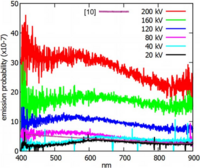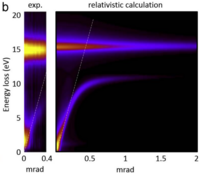Optical excitation by electron beam techniques
Optical excitations can be caused by various reasons. Common is, that the electron beam has to lose some energy depending on the excitation itself. Following luminescent signals can be observed:
- Electron hole pair recombination, after prior electron hole pair creation. This is the classical cathodoluminescence.
- Cerenkov-Vavilov radiation excitation. This kind of radiation is excited when a swift charged particle (the electrons in the TEM) pass through a medium fasted as light would be inside this medium.
- Transition radiation. It is excited if when a charged particle passes through an interface between two media with different dielectric functions. Inside the TEM trasition radiation is excited at the upper and lower sample surface.
For studying such excitations two methods are available:
- Optical spectrometry: for this purpose the GATAN VULCAN system is available at the USTEM laboratory. Originally it is designed for classical cathodoluminescence only but can be used for all luminescent signals in the range from 300 - 1100 nm. Important is the exact knowledge of the angular distribution of the emitted light with rerspect to the detection geometry.
- Electron energy loss spectrometry: Due to the fact that the excitation of optical excitations requests an energy transfer from the electron beam to the excitation, such excitations can also be detected in the EELS signal. For this purpose a GATAN GIF Tridiem and a GATAN GIF 2001 are available at the USTEM laboratories.




